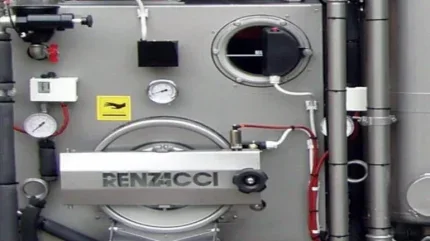
While modern drycleaning machines incorporate many interlocks and safety mechanisms, the still cleaning operation remains the area where serious accidents involving solvent spillage or vapour escape are still likely to occur and can place both staff and customers at risk. It is also the case that many unit shops have residential accommodation above the business and any accident involving a major vapour escape could also place residents at risk from solvent fumes. In particular, operators of perchloroethylene machines should bear in mind that the solvent has anaesthetic properties and therefore anyone with health conditions such as heart failure or emphysema will be at great risk from a major vapour escape.
In my experience accidents relating to the operation of the still, continue to happen on a regular basis, although the majority go unreported. It is the responsibility of the business owner to ensure that staff are not allowed to operate drycleaning machines unless they are competent and have been fully trained in all aspects of machine operation and day to day routine maintenance.
There are several, serious risks associated with cleaning the still that all operators should be very much aware of :-
- Residue stuck in the door seal, this can easily result in a major solvent escape.
- Cracked or hardened door seals can also result in a major solvent escape.
- Failure to close the still door properly. Usually associated with the still door safety switch requiring adjustment.
- A large unexpected volume of solvent in the still when the door is opened.
- A faulty still door safety switch which may stick in the closed position (can easily happen if residue is spilt on the switch). The machine will then register the still door closed when it is open.
Major spillages which can involve the emergency services are invariably associated with the operator’s failure to follow a safe still cleaning procedure.
The two most common issues are a large unexpected volume of solvent remaining in the still when the door is opened and major leaks from the door following still cleaning. Note – the door safety switch should be checked on a regular basis for correct adjustment.
I would recommend that operators adopt the following still rake out procedure. This procedure will ensure that the risks involved in cleaning the still are reduced to an absolute minimum.
SAFETY FIRST
It is fundamental to safety that stills are always raked out cold.
Eye protection, gloves and suitable clothing should be worn for still cleaning. Although operators are not normally exposed to higher vapour concentrations than when loading the machine it is a sensible precaution to wear a carbon lter face mask when raking out the still, particularly if you are going to spend some time cleaning the back wall and sides.
1. As far as possible make sure the still is empty (except for the residue) before proceeding to open the door. Visual access through the sight glass is sometimes restricted by debris.
2. When opening the still door slacken the nut and ease the door slightly open keeping the hasp closed. If unexpected solvent remains in the still the door can then be easily closed avoiding any risk of a major uncontrolled spillage.
3. When the door is opened the still rake out must not be interrupted, always complete the rake out yourself. Transferring the responsibility to another, has in the past, led to accidents.
4. Before closing the door clean the sight glass, make sure the door seal is clean, in good condition and that the sealing surfaces are clean.
5. After cleaning the still check the still door as soon as solvent is pumped to the still to ensure that solvent is not leaking from the door seal.






